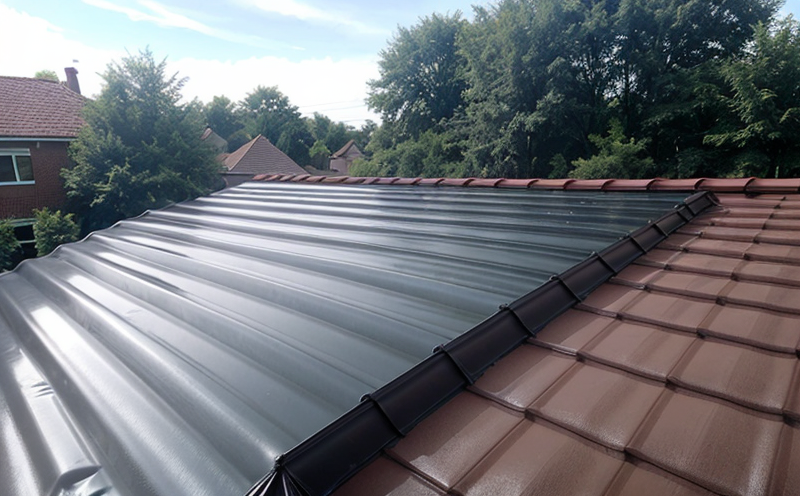ISO 9839 Liquid Applied Roofing Waterproofing Performance
The ISO 9839 standard provides a robust framework for evaluating the waterproof performance of liquid-applied roofing systems. This test method is essential for ensuring that roofs are effective in preventing water penetration, which is critical to maintaining structural integrity and extending the lifecycle of buildings.
The testing process involves several key steps: preparation of the specimen, application of the liquid-applied membrane, curing time, and subsequent hydrostatic pressure testing. The specimen is typically a 1 m² panel that simulates real-world roof conditions. After applying the waterproofing material in accordance with the manufacturer’s specifications, it must cure for an appropriate period to ensure strength and adhesion.
The primary focus of the ISO 9839 test is on hydrostatic pressure testing, where a controlled amount of water is applied to one side of the specimen. The system is monitored for leaks or penetration over time. This process not only evaluates the integrity of the waterproofing layer but also assesses its ability to withstand long-term exposure to environmental conditions.
The standard specifies acceptance criteria based on both visual inspection and quantifiable data, ensuring that any defects are identified early in the testing cycle. Compliance with these criteria is essential for achieving reliable and durable roof systems that meet industry standards.
Understanding the broader context of building & infrastructure testing helps to appreciate why this specific test is so important. In sectors like construction and real estate, where quality assurance is paramount, ISO 9839 ensures that roofs are not just installed but also function effectively in protecting buildings from water intrusion.
| Key Parameters | Description |
|---|---|
| Cure Time | The duration required for the waterproofing material to reach full strength and adhesion. |
| Hydrostatic Pressure | The controlled water pressure used during testing to evaluate resistance. |
| Specimen Size | 1 m² panel used as a representative sample for testing. |
| Testing Duration | The period over which the specimen is subjected to hydrostatic pressure. |
In summary, ISO 9839 provides a comprehensive approach to evaluating liquid-applied roofing waterproofing performance. This test method ensures that roofs are not only installed correctly but also perform effectively in preventing water penetration. The results of this testing are crucial for quality managers and compliance officers responsible for ensuring building integrity.
Industry Applications
The ISO 9839 Liquid Applied Roofing Waterproofing Performance test is widely applicable across various sectors where waterproofing is critical. This includes commercial buildings, industrial facilities, and residential properties. Below are some specific applications:
- Commercial Buildings: Ensuring the longevity of large-scale structures by preventing water damage.
- Industrial Facilities: Protecting equipment and infrastructure from environmental hazards.
- Residential Properties: Enhancing home safety and reducing maintenance costs over time.
| Sector-Specific Challenges | Solution with ISO 9839 |
|---|---|
| Prolonged exposure to weathering conditions | Testing waterproof performance under controlled pressure simulating real-world conditions. |
| Economic pressures on building costs | Identifying cost-effective yet durable materials through rigorous testing. |
The application of ISO 9839 in these sectors not only enhances the performance of roofing systems but also contributes to sustainable development by promoting the use of high-quality, long-lasting materials.
Quality and Reliability Assurance
Ensuring quality and reliability in liquid-applied roofing waterproofing is critical for building & infrastructure projects. The ISO 9839 test method plays a pivotal role in this process by providing a standardized approach to evaluating performance.
The testing procedure begins with the preparation of specimens, which are carefully fabricated to simulate real-world roof conditions. This step ensures that the material being tested accurately reflects how it will perform under actual use. The application of the waterproofing membrane follows strict guidelines provided in the standard, ensuring consistency across multiple tests.
After curing, the specimen undergoes hydrostatic pressure testing, where water is applied to one side of the panel for a specified duration. This test simulates real-world conditions and provides quantifiable data that can be used to assess performance accurately. Visual inspections complement this process by identifying any defects or areas of concern.
The acceptance criteria set out in ISO 9839 ensure that only materials meeting stringent standards are approved for use. Compliance with these criteria is essential for achieving reliable and durable roof systems, which are critical components of building integrity.
By adhering to the ISO 9839 standard, quality managers and compliance officers can have confidence in the performance of liquid-applied roofing waterproofing materials. This not only enhances the overall quality of buildings but also contributes to long-term cost savings by reducing maintenance needs.
Customer Impact and Satisfaction
The implementation of ISO 9839 has a significant positive impact on customers, particularly in sectors like building & infrastructure. By ensuring the quality and reliability of liquid-applied roofing waterproofing materials, this standard enhances customer satisfaction through several key benefits:
- Improved Durability: Enhanced lifespan of buildings and structures.
- Reduced Maintenance Costs: Fewer repairs needed due to effective waterproofing.
- Safety Enhancements: Protection against water damage, which can be hazardous in certain environments.
- Eco-Friendly Solutions: Promoting the use of sustainable materials and practices.
The standard also supports customer satisfaction by providing clear guidelines for testing and acceptance criteria. This transparency ensures that all stakeholders have a consistent understanding of what is expected, leading to more reliable outcomes.





